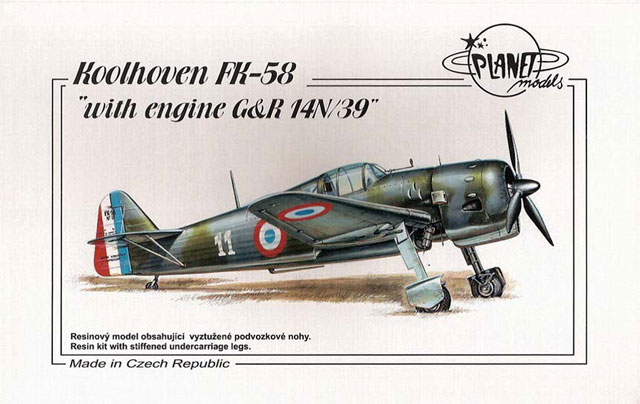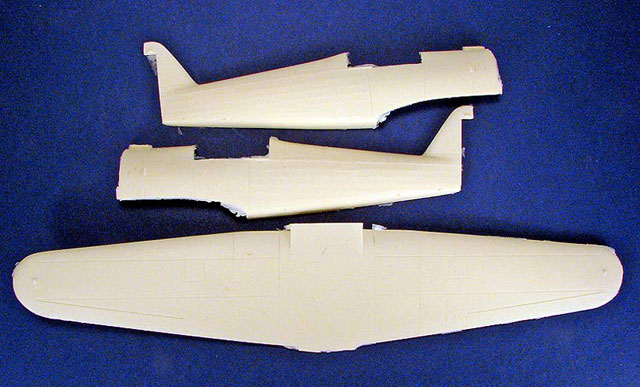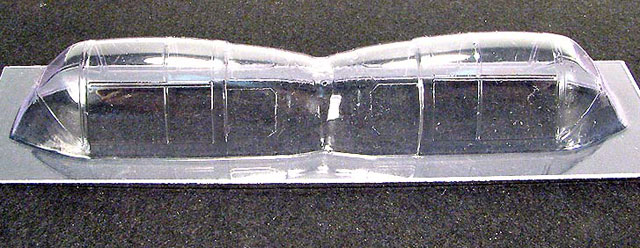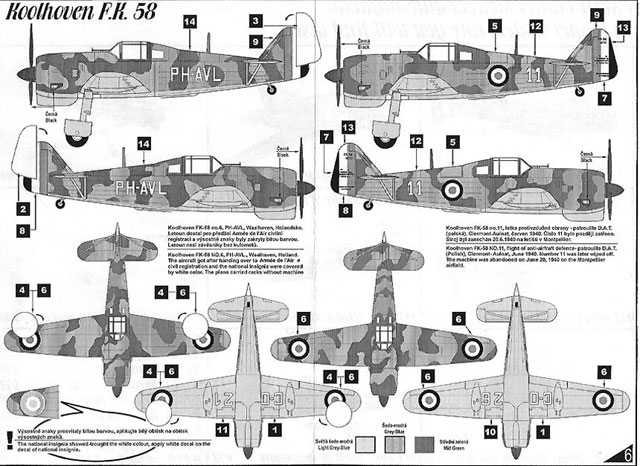|
Koolhoven F.K. 58

Planet Models, 1/48
S
u m m a r y
|
| Catalogue Number: |
090 -
Koolhoven F.K. 58 |
| Scale: |
1/48 |
| Contents and Media: |
68 pieces in
cream colored resin and 2 clear vac-form canopies. Instructions,
painting guide and decal sheet for 2 aircraft. |
| Price: |
USD $49.96 from Squadron.com |
| Review Type: |
FirstLook - In Box |
| Advantages: |
Nicely
engraved panel lines and fabric surfaces. Single piece cowling without
pour stub. |
| Disadvantages: |
A bit of
flash on many parts, extremely delicate parts in resin. Requires use of
cyanoacrylic (super / crazy) glue and /or two-part epoxy. |
| Recommendation: |
Highly recommended for modelers who
have experience with resin kits and parts. |
Reviewed by Steven "Modeldad" Eisenman

Planet Models' 1/48 scale Koolhoven F.K. 58
is available
online from Squadron
Last minute shopping...
With war clouds gathering over Europe, the French
military went on a last minute buying spree to help build-up its
inadequate air force. With Britain focusing on its own needs, and the
United States providing what it could, the French turned to the
Netherlands.
After shopping at Fokker, which was too busy, the French went to
Koolhoven Vliegtuigen, where Frederik Koolhoven agreed to build the
French a fighter, which was designated as Model 1166 and then F.K. 58 (Koolhoven’s
58th aircraft project).
The aircraft itself was of mixed construction. The aft portion of the
fuselage was made of steel tubes covered in fabric. The forward
fuselage was Duralumin. The wing was of a single span going through the
fuselage. It was of wood construction covered in plywood.
In a mere three months a prototype was produced. In July 1938 the
prototype was taken to France for display. Even though it did not meet
the speed requirements the French set, it was listed as the “fastest
fighter in the world”. The speed used was that of the aircraft in a
dive, not level flight.
The French put in an order for 50 aircraft in January 1939. In May
1939, the first four aircraft arrived, but were equipped with Hispano-Suiza
engines, rather then the specified Gnome & Rhone engines. These four
were rejected and sent off to second line duties.
By the time war broke out in September 1939, only
10 aircraft had arrived. By December, there were 40 assembled and
another 23 unassembled aircraft in France. Of the 40 assembled K.H. 58s,
only 18 made it into service, but without a clear purpose. The entire
front line use of the F.K. 58 amounted to only 47 or so operational
sorties. After the armistice, all were scrapped.
Following on their beautifully done XP-40Q resin
kit, Planet Models has produced another quality resin kit of a very
minor aircraft of WW-2.
Unlike the XP-40Q, however, there are no etched metal parts. Rather, the
very fine parts are done in resin. Removing these parts from their
molding blocks, and cleaning them up, as there is a small amount of
flash, will require great care.

Click
the thumbnails below to view larger images:
When you open the parts bags and spill them onto
your work surface, there appears to be an infinite number of infinitely
small resin parts. I actually received an additional set of five engine
cylinders to add to the pile. One thing that Planet models should be
commended on is that the longer thinner resin pieces, such as the tail
plane supports were packed separately, in a small bag, with a piece of
cardboard to prevent bending and breaking.
Also, unlike the XP-40Q kit, this kit will require a little more cleanup
on the fuselage mating surfaces and on the leading edge of the wing.
But a quick test fit showed that once the cleanup is done, the wing to
fuselage join is excellent.
What I found amazing in this resin kit was that the cowling is molded as
a single piece, but there is not the usual pour stub that must be
removed. The cowling is very thin and even the little cooling vents at
the top are open.
There are two very thin and clear vac-form canopies.

The canopy frames are distinct so masking will be
reasonably easy. It should be noted that the rear part of the canopy
forms part of the fuselage. It may be better to attach the canopy prior
to painting to insure a clean join between canopy and fuselage.
Markings
The first set of markings is for a “pre-delivery”
aircraft, at Waalhaven, Netherlands, in civilian registration, PH-AVL,
without machine guns mounted. The French roundels and rudder stripes
were covered over. The kit provides white decals that are to be used to
cover over the tri-color roundels and rudder stripes. As in pictures of
the actual aircraft, the tri-color should be barely visible.
The second set is for an aircraft of an anti-aircraft defense patrol
D.A.T. (Polish) at Clermont-Aulnat, June 1940. This aircraft uses the
full national markings and merely has the number 11 on the rear of the
fuselage.

I am quite glad to see that the registration information that appears on
the rudder stripes are separate decals. I prefer to paint rudder
stripes, rather than use the kit decals.
As for camouflage colors, the instruction show the aircraft in a two
color topside scheme, rather than a three color scheme. The underside
is Light Blue-Gray, the topside is the Dark Blue-Gray with Mid-Green (Kahki)
disruptive pattern randomly applied.
While the use of only two topside colors is more unusual, it was used on
a number of different fighter types, including the Bloch. Also, the
pictures of “11”, although in black and white, give a distinct
impression that only two topside colors were used.
I must admit that while this is an very nice kit,
its appeal may be limited to those who have a thing for little known
aircraft or the WW-2 French Air Force. No question that the F.K. 58 is
probably rivaled only by the Ambrosini SAI 207 (which was done in resin
by LF Models) as one of the least known and less successful fighters of
the Second World War.
For those who want something quite different and who want to work with
resin, I highly recommend this kit.
References
French Aircraft 1939-1942, Volume 2: From Dewotine
to Potez; by Andre Jouineau and Dominique Breffort; published by
Histoire & Collections; 2005.
Thanks to MPM / Planet Models for the review sample.
MPM
and Planet Model
kits are available worldwide through hobby retailers
worldwide
and at
Squadron.com
Review and Images Copyright © 2005 by
Steven Eisenman
Page Created 16 August, 2005
Last updated 15 August, 2005
Back to HyperScale Main Page
Back to Reviews Page
|
Home | What's
New | Features
| Gallery |
Reviews | Reference
| Forum
| Search